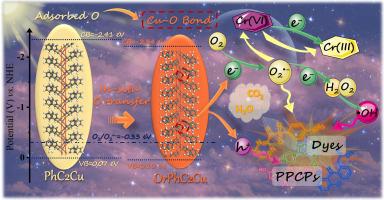当前位置:
X-MOL 学术
›
J. Colloid Interface Sci.
›
论文详情
Our official English website, www.x-mol.net, welcomes your
feedback! (Note: you will need to create a separate account there.)
Insights into copper(I) phenylacetylide with in-situ transformation of oxygen and enhanced visible-light response for water decontamination: Cu–O bond promotes exciton dissociation and charge transfer
Journal of Colloid and Interface Science ( IF 9.4 ) Pub Date : 2024-05-22 , DOI: 10.1016/j.jcis.2024.05.159 Zili Lin 1 , Zhenjun Xiao 1 , Yang Liu 2 , Yishun Wang 1 , Shuyue Chen 3 , Jinfan Zhang 1 , Yingyi Chen 1 , Xiaoyu Zhang 1 , Ge Zhang 1 , Daguang Li 4 , Wenying Lv 1 , Ping Chen 1 , Guoguang Liu 1
Journal of Colloid and Interface Science ( IF 9.4 ) Pub Date : 2024-05-22 , DOI: 10.1016/j.jcis.2024.05.159 Zili Lin 1 , Zhenjun Xiao 1 , Yang Liu 2 , Yishun Wang 1 , Shuyue Chen 3 , Jinfan Zhang 1 , Yingyi Chen 1 , Xiaoyu Zhang 1 , Ge Zhang 1 , Daguang Li 4 , Wenying Lv 1 , Ping Chen 1 , Guoguang Liu 1
Affiliation

|
The widespread contamination of hexavalent chromium (Cr(VI)), pharmaceuticals and personal care products (PPCPs), and dyes is a growing concern. necessitating the development of convenient and effective technologies for their removal. Copper(I) phenylacetylide (PhCCu) has emerged as a promising photocatalyst for environmental remediation. In this study, we introduced a functional Cu–O bond into PhCCu (referred to as OrPhCCu) by creatively converting the adsorbed oxygen on the surface of PhCCu into a Cu–O bond to enhance the efficiency of Cr(VI) photoreduction, PPCPs photodegradation, and dyes photodegradation through a facile vacuum activating method. The incorporation of the Cu–O bond optimized the electron structure of OrPhCCu, facilitating exciton dissociation and charge transfer. The exciton dissociation behavior and charge transfer mechanism were systematically investigated for the first time in the OrPhCCu system by photoelectrochemical tests, fluorescence and phosphorescence (PH) techniques, and density functional theory (DFT) calculations. Remarkably, the enhanced visible-light response of OrPhCCu improved photon utilization and significantly promoted the generation of reactive species (RSs), leading to the highly efficient Cr(VI) photoreduction (98.52% within 25 min) and sulfamethazine photodegradation (94.65% within 60 min), with 3.91 and 5.23 times higher activity compared to PhCCu. Additionally, the photocatalytic efficiency of OrPhCCu in degrading anionic dyes surpassed that of cationic dyes. The performance of the OrPhCCu system in treating electroplating effluent or natural water bodies suggests its potential for practical applications.
中文翻译:

深入了解苯乙炔铜 (I) 与氧的原位转化和增强的可见光响应以实现水净化:Cu-O 键促进激子解离和电荷转移
六价铬 (Cr(VI))、药品和个人护理产品 (PPCP) 以及染料的广泛污染日益引起人们的关注。需要开发方便有效的技术来去除它们。苯乙炔铜(I)(PhCCu)已成为一种有前途的环境修复光催化剂。本研究通过创造性地将PhCCu表面吸附的氧转化为Cu-O键,在PhCCu(简称OrPhCCu)中引入功能性Cu-O键,以提高Cr(VI)光还原、PPCPs光降解效率,并通过简便的真空活化方法进行光降解染料。 Cu-O键的结合优化了OrPhCCu的电子结构,促进激子解离和电荷转移。通过光电化学测试、荧光和磷光(PH)技术以及密度泛函理论(DFT)计算,首次系统地研究了OrPhCCu系统中的激子解离行为和电荷转移机制。值得注意的是,OrPhCCu 增强的可见光响应提高了光子利用率,并显着促进了活性物质 (RS) 的产生,从而实现高效 Cr(VI) 光还原(25 分钟内 98.52%)和磺胺二甲嗪光降解(60 分钟内 94.65%)。分钟),其活性比 PhCCu 高 3.91 倍和 5.23 倍。此外,OrPhCCu在降解阴离子染料方面的光催化效率超过了阳离子染料。 OrPhCCu 系统在处理电镀废水或天然水体方面的性能表明了其实际应用的潜力。
更新日期:2024-05-22
中文翻译:

深入了解苯乙炔铜 (I) 与氧的原位转化和增强的可见光响应以实现水净化:Cu-O 键促进激子解离和电荷转移
六价铬 (Cr(VI))、药品和个人护理产品 (PPCP) 以及染料的广泛污染日益引起人们的关注。需要开发方便有效的技术来去除它们。苯乙炔铜(I)(PhCCu)已成为一种有前途的环境修复光催化剂。本研究通过创造性地将PhCCu表面吸附的氧转化为Cu-O键,在PhCCu(简称OrPhCCu)中引入功能性Cu-O键,以提高Cr(VI)光还原、PPCPs光降解效率,并通过简便的真空活化方法进行光降解染料。 Cu-O键的结合优化了OrPhCCu的电子结构,促进激子解离和电荷转移。通过光电化学测试、荧光和磷光(PH)技术以及密度泛函理论(DFT)计算,首次系统地研究了OrPhCCu系统中的激子解离行为和电荷转移机制。值得注意的是,OrPhCCu 增强的可见光响应提高了光子利用率,并显着促进了活性物质 (RS) 的产生,从而实现高效 Cr(VI) 光还原(25 分钟内 98.52%)和磺胺二甲嗪光降解(60 分钟内 94.65%)。分钟),其活性比 PhCCu 高 3.91 倍和 5.23 倍。此外,OrPhCCu在降解阴离子染料方面的光催化效率超过了阳离子染料。 OrPhCCu 系统在处理电镀废水或天然水体方面的性能表明了其实际应用的潜力。































 京公网安备 11010802027423号
京公网安备 11010802027423号